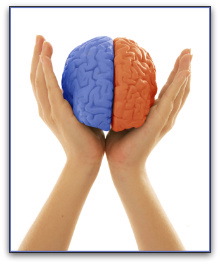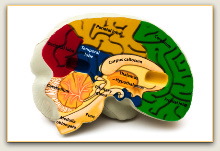
Left-brained individuals problem solve, analyze data, enjoy crunching numbers and statistics, whereas right-brained individuals create paintings, design buildings and compose symphonies, according to numerous articles and books trying to “sell” a clearly defined split in brain functions.
But is this actually true? Is it based on solid scientific findings? Is the brain this neatly divided into two distinct hemispheres, each defining a clear set of talents and abilities? Not exactly, at least not according to the scientist responsible for coining the left (analytical) and right (creative) brain dichotomy.
The brain research conducted by the Cognitive Neuroscientist Michael S. Gazzaniga for the past 45 years has fundamentally changed how neuropsychologists and neuroscientists view brain hemispheres and function. But the science behind the split brain aims to uncover something much different than what has been popularized and made into an industry of its own.
In a 2008 interview with Natasha Mitchell, a science journalist and host of the blog “All In The Mind,” Gazzaniga discussed the groundbreaking research that started the left and right brain phenomena – which is also called lateralization. Entitled “split-brain research,” it took place at the California Institute of Technology (Caltech) in the 1960s. (In scientific literature, the terms lateralization, hemisphere specialization and asymmetry hemispheric differences are used interchangeably.)
Gazzaniga started in the Caltech laboratory as a graduate student, working with Roger W. Sperry, a neuropsychologist and neurobiologist who went on to win the Nobel Prize in Medicine in 1981.
The purpose of the research was to try and understand if the two sides of the brain were co-equal in purpose and function, or if a hierarchy existed. In studying the two sides of the brain, researchers were trying to investigate and understand the concept of consciousness, or how the “brain enables the mind.” In other words, how does an individual develop a sense of “self” or “personhood?”
The studies into consciousness began with a unique population of patients – epileptic patients who had undergone a radical type of brain surgery that lesioned or “cut” a major pathway within the brain.
Splitting the Brain
During his interview with Natasha Mitchell, Gazzaniga described the split-brain research using the case of “WJ,” a World War II veteran who had epilepsy and had the radical surgery to help this condition.
WJ typified one of a handful of epileptic patients with seizures so severe that surgery was considered the only option. During the 1950s and 1960s, effective medications didn’t exist for controlling the seizures, and what doctors found was that seizure activity starting in one hemisphere of the brain could spread to the other hemisphere, causing damage there as well. Two surgeons discovered, however, that if you cut the largest pathway linking the two sides of the brain – the corpus callousm – it prevented these “bilateral seizures.”
Before undergoing the surgery, the Caltech scientists gave WJ a series of neuropsychological tests in which he performed normally in terms of cognitive functioning. At age 50, his recovery was slow, but like other patients who had this surgery, he regained seemingly “normal” psychological functioning post-operative. For many of these patients, the surgery reduced epileptic seizures. For some patients, the surgery eliminated seizures altogether. Most patients reported feeling better after the surgery, and returned to “normal” functioning within a reasonable amount of time. The verbal IQ of the patients remained in tact after the surgery, as did other important cognitive abilities, such as the ability to problem-solve.
This produced a paradox: how could severing the major pathway between hemispheres not affect psychological and cognitive functioning.? Why weren’t two consciousness systems in place after the surgery? These initial questions were what intrigued the Caltech researchers.
Left to Right, and Right to Left
Before the Caltech scientists conducted the split-brain experiments, they knew about the overall functions of the two brain hemispheres from studying stroke patients, those with brain tumors, and other brain diseases and dysfunctions. For example, they knew that the left hemisphere was largely responsible for language and talking, and that the right hemisphere for focusing attention and perceptions.
They also knew that when an individual views an object, everything to the left of a fixation point (or object) is processed by the brain’s right hemisphere. And everything to the right of a fixation point is processed by the brain’s left hemisphere. This also is true for how the body processes information coming from the left and right hands – sensory input from the left hand is processed on the brain’s right side, whereas sensory input from the right hand is processed on the brain’s left side.
And since the right side of the brain isn’t a “talker,” as Gazzaniga describes the right hemisphere, the scientists knew that in order for individuals to properly articulate what they saw in their left visual field, information must pass from the brain’s right hemisphere to the left hemisphere.
To test WJ’s two brain hemispheres – now completely split as a result of the surgery – the researchers set him before a screen, and using a specialized research instrument called a tachistoscope, presented an image of an apple first to his right visual field – or his left brain. When asked what he saw, he replied: “ I saw an apple.”
But when the apple was shown to his left visual field – or his right brain – he replied: “ I didn’t see anything.” However, when given a paper sack with objects in it, he could put his left hand on the apple – but as long as he couldn’t see the apple, he couldn’t tell the scientists what he was holding.
Gazzaniga told Natasha Mitchell that the results from this study were startling. “No one was prepared to think that you could divide human consciousness in this simple way.”
In other words, no one thought that individuals had two separate systems in their brain, that one side literally couldn’t tell what the other side of the brain was doing or seeing.
Ongoing Split-Brain Research
Twenty years after those initial experiments, Gazzaniga said that he and other researchers came up with the idea to ask split-brain patients specific questions about what they thought was happening during the experiments.
For example, if the researchers placed an image of an apple in the patient’s right brain hemisphere, and then the patient pulled an apple out of a paper sack using his left hand, the researchers asked the patient why he thought that he pulled an “apple” from the sack.
To the researchers amazement, the patient came up with a totally fabricated story of why he had pulled an apple from the bag. The “story” was an attempt to explain or interpret his behavior, to make sense out of what he didn’t know.
In “Spheres of Influence,” a 2008 article for Scientific American Mind, Gazzaniga explained this concept of the left brain trying to explain behaviors about which it had no information. He detailed another experiment he did with a split-brain patient, showing him two pictures: the left brain saw a chicken claw while the right brain saw a snow scene.
A number of pictures were then placed before the patient, and he was asked to select from them. His right hand (left brain) chose a chicken while his left hand (right brain) chose a shovel.
The researchers then asked him why he chose those particular pictures. He explained: “Oh, that’s simple. The chicken claw goes with the chicken, and you need a shovel to clean out the chicken shed.”
In the article, Gazzaniga explains that the left brain, having no knowledge of the snow scene, or why he would select the “shovel,” tried to explain it in context of the chicken claw – the only image that his left brain saw and could articulate. This side of the brain had no idea that the right brain had viewed a snow scene.
But, Gazzaniga theorized, the left brain had to explain why he had selected the shovel, to make sense of the activity and the world. This proclivity of the left brain hemisphere to explain behaviors gave Gazzaniga the concept of the left brain as “the interpreter.” Even if the interpretation is wrong, the left brain goes to work trying to find meaning – even when meaning isn’t there.
Normal Brains and Consciousness
So, Gazzaniga said, it appears that each side of the brain does have “specialized” functions, as the left brain is now considered the ‘interpreter” or “problem solver” as well as the center for most language skills. Yet the right brain has importance as well, especially in terms of perceptual grouping, and in accurately identifying and later recalling groups of objects presented to it.
“The advantage of having a dual system is obvious,” Gazzaniga writes in the Scientific American Mind article. “The right hemisphere maintains an accurate record of events, leaving the left hemisphere free to elaborate and make inferences about the material presented. In an intact brain, the two systems complement each other, allowing elaborative processing without sacrificing veracity.”
Now consider the fact that in addition to having two hemispheres, scientists now know that the brain has about 100 billion neurons, and each, on average, connecting to approximately 1,000 other neurons. That translates into about 100 trillion synaptical connections. Given the research on split-brain patients in the context of neuronal wiring, how do neuroscientists today view human consciousness?
In normal individuals, the brain has countless mental structures distributed throughout, with local circuits enabling certain types of conscious thought. Somehow, all of these distributed circuits become activated and part of our conscious awareness, according to Gazzaniga.
A split-brain patient who has had his or her brain disconnected has literally lost all consciousness about what is occurring in the other side of the brain. The consciousness that does exist in one hemisphere probably results from activated neural circuits in that area of the brain.
In normal, connected brains, those neural circuits located throughout the brain connect and activate when a particular conscious moment arises. As Gazzaniga describes it, “each of the thousands if not millions of conscious moments that we have reflects one of our networks being up for duty.”
It’s those millions of conscious moments that keep researchers like Gazzaniga searching for even more answers. If you are interested in what makes individuals unique through their conscious states, consider getting a degree in psychology. A Ph.D. is required to work in laboratories conducing research and publishing articles reporting research results and conclusions.
A psychology degree prepares individuals for degrees as neuropsychologists, cognitive neuropsychologists, and cognitive neuroscientists.
The Corpus Callosum

A thick nerve tract running down the brain’s middle, the corpus callosum, connects the brain’s left and right hemispheres. Throughout childhood it develops slowly, reaching full maturity in late adolescence. Deposits of myelin build up on the nerve fibers during the maturation process so that by early adulthood between 200 and 800 million myelinated axons run transversely between the hemispheres.
In normal brain function, the two hemispheres work together, sharing information across the corpus callosum. In epileptic patients, a surgical operation splits the corpus callosum to prevent the spread of epileptic seizure from one hemisphere to another. Effective medications are now available so that this surgery is rarely performed.
However, some individuals are still born with disorders of the corpus callosum. Although rare, some individuals are born with severely deformed or a missing corpus callosum – called callosal agenesis.
Similar to findings from studies of epileptic patients who have had the corpus callosum lesioned, those with callosal agenesis generally have lateralized language functioning in the brain’s left hemisphere, and spatial skills lateralized in the right hemisphere. However, some individuals with callosal agenesis have specific difficulties involving both language and spatial abilities.
Scientists hypothesize that these language and spatial difficulties result from the inability of certain neurons being unable to pass between the two hemispheres. For more information about corpus callosum disorders, see the website for the National Organization for Disorders of the Corpus Callosum.